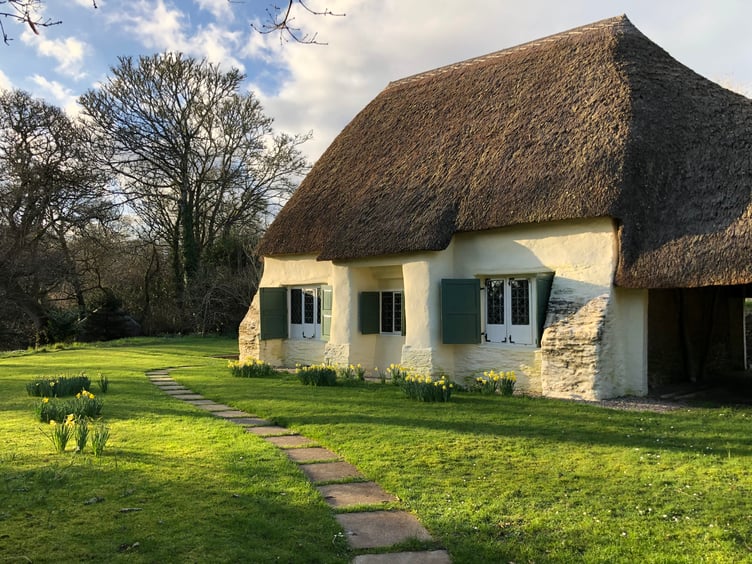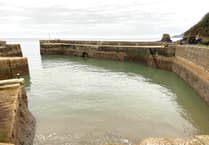On a sunny spring day, there can be fewer places on earth more beautiful than the Grade 1 listed Quaker meeting house at Come-to-Good, near Truro. This charming thatched cottage sits amid woodland humming with birdsong, the ground a mass of colour and softly scented with English bluebells and wild garlic.
One imagines that the world appeared much the same when it was built over three centuries ago, in 1710. “Come-to-Good is timeless,” says Quaker fundraiser Maurice Matthews. “Apart from the electric lighting, there’s no clue in that building to tell a visitor that it’s the 21st century.”
In its heyday, as many as 1000 friends might have gathered here, spilling out into the open and perhaps listening on horseback (steps for mounting equines remain here). Today’s weekly congregation numbers a more modest 30. A discreet circle of wooden chairs reflects the quiet way in which Quakers practise their faith: as a relationship between God and each individual, with no need for ritual or intermediary.
Outside, a linhay acted as a stable and later as an outside prayer space during the pandemic. Peaceful woodland is dotted with gravestones including that of Catherine Payton Phillips, a travelling Quaker minister from the 18th century.
So secluded is this spot, even many locals remain unaware of its presence, despite its proximity to Cornwall’s only city and the National Trust honeypot of Trelissick.
And yet it is a cornerstone of the historic presence of Quakers in the county, dating back to the arrival of George Fox in 1656. Maps from that time show this as one of the principal routes between Truro to Falmouth, the name Cym-ty-coit meaning “the coombe by the dwelling in the wood”.
As the founder of what was known as the Society of Friends, Fox was arrested during his preaching mission to the Westcountry, ostensibly for having long hair. For this, and the additional offence of not removing his hat in court, he was held prisoner at Launceston Castle for eight months; so squalid were the conditions of his cell in the north gatehouse, it was nicknamed ‘Doomsdale’.
It's a window into the challenges Quakers have faced in the past. While they are characterised by their peaceful beliefs, in more devout times their worship was seen as subversive, even blasphemous. They were persecuted, and the name itself mocked their belief in the biblical passage that people should "tremble at the Word of the Lord".
“People visit Come-to-Good for the pretty building, but the Quaker faith itself is radical, anti-establishment, non-conformist - from the refusal to pay tithes to fund the established church, to the refusal to bear arms during wars,” says Maurice. “Early Quakers were frequently in court or in prison; some died.” Today’s members are just as active in fighting for the minority rights including prison reform and refugee care.
There are no ministers or, to put it another way, every man, woman and child is a minister. Meetings vary from a full hour of silence to more vocal gatherings. “You can minister in silence or by standing up and sharing your thoughts, praying, singing, even crying,” Maurice explains. “You have to be brave.”
There are unwritten rules. “You should only break into the silence once, and others should wait to respond rather than jumping to their feet, speaking to the meeting rather than the person. Don’t proclaim you have the answers – the longer you spend as a Quaker, the fewer answers you have, and the happier you feel about not knowing.”
Elders – known, somewhat unflatteringly, as “weighty friends” - once sat in elevated positions, considered influential though experience. Come-to-Good’s elder benches are no longer used in the hierarchical sense but have been retained due to the building’s listed status. “It’s now considered anathema to have anyone above,” says Maurice. Similarly, management roles are rotated to prevent anyone being perceived as being in charge.
The influence of the Quakers in Cornwall cannot be overestimated. The Fox family (no relation to founder George) launched Perran Foundry in 1791, followed in 1832 by the Cornwall Polytechnic Society - the first use of the word “Polytechnic” in Britain - to promote the ideas and inventions of foundry workers. The Poly is used today as a venue to promote the arts, but look closely for the spot where Alfred Nobel first demonstrated the explosive properties of nitroglycerine here in 1865, taking a chunk out of the building.
Trebah House and Garden was bought by the Fox family in 1838, using wealth built on shipping, engineering, geology, mining, philanthropy and more. Charles Fox moved in in 1851; his brother, Alfred, bought Glendurgan next door, while a third brother, Robert, moved into Penjerrick. Together, they created several stunning gardens, including Fox Rosehill and Meudon. Alfred’s descendant – also Charles Fox – lives at Glendurgan now and is a garden designer.
Come-to-Good is one of four meeting houses in Cornwall. Marazion is the oldest, built in 1688; its aged roof was recently renewed with Delabole slate, the floor relaid with rescued timber and a sustainable heating system bringing the building into the 21st century. Truro and St Austell’s Meeting Houses are both Grade II-listed and date back to the 1820s; Truro’s was opened by none other than prison reformer Elizabeth Fry.
Come-to-Good is certainly the most attractive, in a chocolate-box fashion, and features on the Small Pilgrim Places Network. It’s open and accessible 24/7 for anyone seeking solace or reflection, and regularly draws gatherings of 30 on Sunday mornings.
But it has its drawbacks. In the winter, it’s cold and dark, says Maurice, who prefers to worship in a more modern community centre in Falmouth (similar arrangements exist in Liskeard, Bude and Penzance). The recent spell of extremely soggy weather has taken its toll on the steeply pitched thatch, with subsequent leaks leaving tell-tale brown streaks on the cob walls. Tarpaulin has been used to mitigate this, but with the added complication of trapping existing moisture in the thatch, resulting in potential composting conditions.
Architectural stone carver Andrew Bird is on the Cornwall Quakers’ property advisory group. He explains how the thatch is popular with nesting birds and other animals seeking a warm environment during colder months. “Some cottages have netting over the thatch to prevent this, but as a Grade 1 listed building, that’s not an option for us,” he says.
This has led the community to seek funding from the likes of Cornwall Historic Churches Trust. As well as fixing the thatch, building in extra overhang to keep rainwater away from the cob, they are keen to install a ground source heat pump to reduce its carbon footprint, and a planet-friendly waste management system. “You can’t have a community here without being able to have a wee,” adds Maurice.
For the work to go ahead, the community needs to raise £200,000. Quakers frown upon gambling, so you’ll find no lottery funding here. “Raising this money will enable us to keep the building in a state that will hopefully mean it will serve the Quaker faith and the wider community for another 300 years,”” says Maurice.
To make a donation towards the cost of the conservation work, go to https://cafdonate.cafonline.org/25432 or click on the link at https://cometogood.quakermeeting.org/


.jpeg?width=209&height=140&crop=209:145,smart&quality=75)


Comments
This article has no comments yet. Be the first to leave a comment.